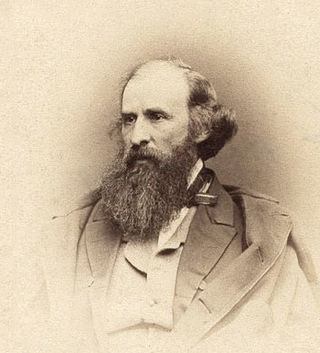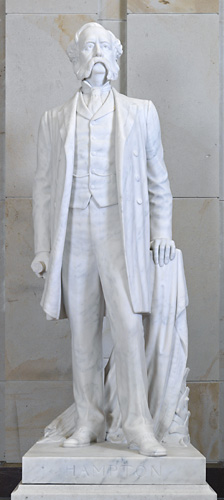
Charles Henry Niehaus, was an American sculptor.

Henry Kirke Brown was an American sculptor.

Henry Merwin Shrady was an American sculptor, best known for the Ulysses S. Grant Memorial on the west front of the United States Capitol in Washington, D.C.

Franklin Bachelder Simmons was a prominent American sculptor of the nineteenth century. Three of his statues are in the National Statuary Hall Collection, three of his busts are in the United States Senate Vice Presidential Bust Collection, and his statue of Ulysses S. Grant is in the United States Capitol Rotunda.

The Hall of Columns is a more than 100-foot-long (30 m) hallway lined with 28 fluted columns in the south wing extension of the United States Capitol in Washington, D.C. It is also the gallery for 18 statues of the National Statuary Hall Collection.
The McNeel Marble Works of Marietta, Georgia, was founded in 1892 by Morgan Louis McNeel and his brother, R. M. McNeel. Its location near the Blue Ridge Mountains provided the firm with access to areas where marble and granite could be quarried.

Brigham Young is a marble statue by Mahonri Young representing the Mormon religious leader of the same name, installed in the United States Capitol, in Washington D.C., as part of the National Statuary Hall Collection. It is one of two statues donated by the state of Utah, and is unusual in the collection in that Young is portrayed sitting down. The statue was unveiled by Alben William Barkley on June 1, 1950.

Henry Clay is a 1929 bronze sculpture by Charles Henry Niehaus depicting the lawyer and politician Henry Clay, installed in the United States Capitol in Washington D.C. as part of the National Statuary Hall Collection. It is one of two statues donated by the state of Kentucky. The statue was accepted into the collection by Virgil Chapman on March 3, 1929.

Wade Hampton III is a 1929 marble sculpture depicting the military officer and politician of the same name by Frederick Ruckstull, installed in the United States Capitol, in Washington D.C., as part of the National Statuary Hall Collection. It is one of two statues donated by the state of South Carolina. The statue was accepted in the collection by Duncan Heyward on June 10, 1929.

George Clinton is an 1873 bronze sculpture depicting the American soldier and statesman of the same name by Henry Kirke Brown, installed in the United States Capitol, in Washington D.C., as part of the National Statuary Hall Collection. It is one of two statues donated by the U.S. state of New York. The statue is one of three by Brown in the Collection.

Nathaniel Greene is an 1870 marble statue of Nathanael Greene by Henry Kirke Brown, installed in the United States Capitol, in Washington, D.C., as part of the National Statuary Hall Collection. It is one of two statues donated by the state of Rhode Island. The statue portrays Greene dressed in the uniform of a Revolutionary War general, holding a sword in his left hand.

Robert M. La Follette Sr. is a 1929 marble sculpture of Robert M. La Follette by Jo Davidson, installed in the United States Capitol, in Washington, D.C., as part of the National Statuary Hall Collection. It is one of two statues donated by the state of Wisconsin. The statue was accepted in the collection by Senator John J. Blaine on April 25, 1929.
Deborah Copenhaver Fellows is an American sculptor known for her Western themed works. Her best known work is the life-sized statue of former Arizona senator Barry Goldwater included in the National Statuary Hall Collection in the U.S. Capitol in Washington D.C. It was added to the collection as one of Arizona’s two statues in 2015.

Jacques Marquette is a statue by Gaetano Trentanove of Jacques Marquette, the best-known version being the 1896 marble one installed in the National Statuary Hall Collection in the Capitol in Washington D.C.

John Hanson is a bronze statue by Richard E. Brooks of Founding Father John Hanson, installed in the United States Capitol, in Washington, D.C., as part of the National Statuary Hall Collection. It is one of two statues donated by the state of Maryland.

John Campbell Greenway is a 1930 bronze statue of John Campbell Greenway by Gutzon Borglum, one version of which was installed in the United States Capitol, in Washington D.C., as part of the National Statuary Hall Collection. It was one of two statues donated by the state of Arizona. The sculpture was unveiled by Senator Henry Ashurst of Arizona on May 24, 1930.

Richard Stockton is a marble sculpture depicting the American lawyer, jurist, legislator of the same name by Henry Kirke Brown, installed in the United States Capitol's crypt, in Washington, D.C., as part of the National Statuary Hall Collection. The statue was donated by the U.S. state of New Jersey in 1888.
















